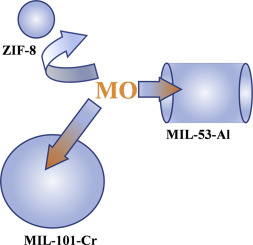Microporous and Mesoporous Materials ( IF 5.2 ) Pub Date : 2020-01-07 , DOI: 10.1016/j.micromeso.2019.109993 Xiaowei Zhang , Libing Qian , Shiju Yang , Yutian Peng , Bangyun Xiong , Jingjing Li , Pengfei Fang , Chunqing He

|
In this work, typical metal-organic frameworks (MOFs) MIL-101-Cr, MIL-53-Al and ZIF-8 with high specific surface areas were synthesized and applied in the removal of anionic dye methyl orange (MO) from water. Nitrogen adsorption and positron annihilation lifetime spectroscopy (PALS) were applied to study the pore characteristics of MOFs and their adsorption of MO, respectively. The specific surface areas of the synthesized MOFs are in the order MIL-101-Cr > ZIF-8>MIL-53-Al. The pore sizes of MOFs obtained from PALS are essentially the same as those from their crystal structure, suggesting that PALS is a useful probe to characterize the pore properties of MOFs. After MO adsorption in MOFs, the nominal mean pore sizes for MIL-101-Cr-MO and MIL-53-Al-MO from nitrogen adsorption are mainly attributed to the interspaces between grains because their inherent pores were occupied by MO molecules as revealed by PALS, while that of ZIF-8-MO represents the inherent pores and interspaces between grains. Langmuir adsorption of MO was found to occur in the MOFs, whereas the MO adsorption behaviors are different depending on the unique pore structures of specific MOFs. MIL-101-Cr and MIL-53-Al show the MO adsorption capacities of 196.08 and 100.0 mg/g due to their large specific surface areas and accessible pore windows, which can provide more accessible unsaturated metal sites. However, despite that the specific surface area of ZIF-8 is larger than that of MIL-53-Al, MO adsorption capacity in ZIF-8 is rather low because the size of its pore windows is smaller than MO dimension, which results in MO molecules inaccessible to the pores. Results showed that methyl orange anions (MO−) were electrostatically attracted by unsaturated metal sites in the cages/channel pores of MIL-101-Cr and MIL-53-Al in aqueous solutions, whereas MO was only adsorbed in the interspaces between grains in ZIF-8.
中文翻译:

氮吸附和正电子an没寿命光谱法研究各种有机金属骨架中甲基橙的吸附
在这项工作中,合成了具有高比表面积的典型金属有机骨架(MOF)MIL-101-Cr,MIL-53-Al和ZIF-8,并将其用于从水中去除阴离子染料甲基橙(MO)。利用氮吸附和正电子an没寿命谱(PALS)分别研究了MOF的孔特征及其对MO的吸附。合成的MOF的比表面积为MIL-101-Cr> ZIF-8> MIL-53-Al。从PALS获得的MOF的孔径与从其晶体结构获得的孔径基本相同,这表明PALS是表征MOF的孔特性的有用探针。在MOF中吸附MO之后,如PALS所揭示的,由于氮的吸附,MIL-101-Cr-MO和MIL-53-Al-MO的名义平均孔径主要归因于晶粒之间的间隙,因为它们的固有孔被MO分子占据,而ZIF -8-MO表示晶粒之间的固有孔和间隙。发现MOF中发生了Langmuir对MO的吸附,而MO的吸附行为则取决于特定MOF的独特孔结构。MIL-101-Cr和MIL-53-Al的MO吸附容量为196.08和100.0 mg / g,这是因为它们的大比表面积和可及的孔窗,可提供更多可及的不饱和金属位点。但是,尽管ZIF-8的比表面积大于MIL-53-Al的比表面积,ZIF-8中的MO吸附能力相当低,因为其孔窗口的尺寸小于MO尺寸,这导致MO分子无法进入孔中。结果表明,甲基橙阴离子(MO−)被水溶液中MIL-101-Cr和MIL-53-Al的笼/通道孔中的不饱和金属位点静电吸引,而MO仅吸附在ZIF-8中的晶粒间空隙中。



























 京公网安备 11010802027423号
京公网安备 11010802027423号